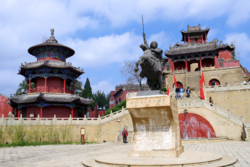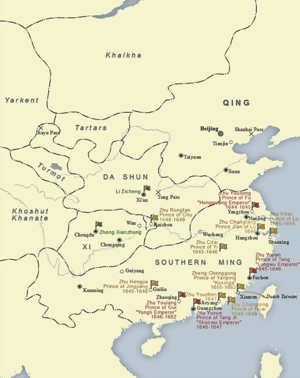Li Zicheng facts for kids
Quick facts for kids Li Zicheng李自成 |
|||||||||||||||||||||
|---|---|---|---|---|---|---|---|---|---|---|---|---|---|---|---|---|---|---|---|---|---|

Monument of Li Zicheng on Mount Panlong, Mizhi County
|
|||||||||||||||||||||
| 1st Emperor of the Shun dynasty | |||||||||||||||||||||
| Reign | 1644–1645 | ||||||||||||||||||||
| Enthronement | 8 February 1644 Xi'an 3 June 1644 Hall of Martial Valor, Shuntian Prefecture |
||||||||||||||||||||
| Successor | Li Zijing | ||||||||||||||||||||
| Emperor of China (Disputed) | |||||||||||||||||||||
| Reign | 1644–1645 | ||||||||||||||||||||
| Predecessor | Chongzhen Emperor (Ming dynasty) | ||||||||||||||||||||
| Successor | Shunzhi Emperor (Qing dynasty) | ||||||||||||||||||||
| Born | Li Hongji (李鴻基) 22 September 1606 Li Jiqian village, Yan'an prefecture, northeast Shaanxi, Ming dynasty |
||||||||||||||||||||
| Died | 1645 (aged 38–39) border of Hubei, Hu'nan and Jiangxi, Qing dynasty |
||||||||||||||||||||
| Spouse | Gao Guiying | ||||||||||||||||||||
|
|||||||||||||||||||||
| Dynasty | Shun dynasty | ||||||||||||||||||||
| Li Zicheng | |||||||||
|---|---|---|---|---|---|---|---|---|---|
| Chinese | 李自成 | ||||||||
|
|||||||||
| Li Hongji | |||||||||
| Traditional Chinese | 李鴻基 | ||||||||
| Simplified Chinese | 李鸿基 | ||||||||
|
|||||||||
| Dashing King | |||||||||
| Traditional Chinese | 闖王 | ||||||||
| Simplified Chinese | 闯王 | ||||||||
|
|||||||||
Li Zicheng (born Li Hongji on September 22, 1606 – died 1645) was a Chinese peasant leader. He was also known by his nickname, Dashing King. In 1644, he led a rebellion that ended the Ming dynasty. He ruled northern China briefly as the emperor of the Shun dynasty before he died a year later.
Contents
Li Zicheng's Early Life
Li Zicheng was born in 1606 in a poor farming family. His village was called Li Jiqian, located in the Yan'an area of northeast Shaanxi province. Li Zicheng had an older brother who helped raise him.
Li Zicheng could read and write, but it's not clear how he learned. When he was young, he worked on a farm, in a wine shop, and as a blacksmith. He also worked as a mailman for the government.
How Li Zicheng Became a Rebel Leader
According to old stories, in 1630, Li Zicheng was put in public shackles. This happened because he could not pay back money he owed to an unfair official. A group of kind peasants helped him escape. They took him to a nearby hill and chose him as their leader.
Even though they only had wooden sticks, Li and his group surprised some government soldiers. This allowed them to get their first real weapons.
The Ming Dynasty's Problems
During the late Ming dynasty, the government was very weak. It had money problems and struggled with bad weather. There were also many diseases, like smallpox, that affected the people.
In 1639, a big sickness called the "Chongzhen Great Plague" spread across northern China. Famine (when there is not enough food) and drought (when there is not enough water) made people even unhappier.
Because of these problems, many peasant uprisings began in 1628. Shaanxi province was the main place where these rebellions started. Li Zicheng and Zhang Xianzhong were two important leaders in these uprisings.
Li Zicheng's Growing Army
In 1633, Li Zicheng joined a rebel army led by Gao Yingxiang. Gao Yingxiang was nicknamed "Dashing King." After Gao died, Li Zicheng took over his army and his nickname.
Within three years, Li gathered more than 30,000 men for his army. They attacked and defeated important government officials in Henan, Shanxi, and Shaanxi provinces. As Li won more battles, his army grew larger.
Many people joined Li's army because he was seen as a hero, like Robin Hood. He was kind to the poor and only attacked Ming officials.
Li Zicheng promised to "divide land equally and stop grain taxes." This idea was very popular with the peasants. People even sang a song that welcomed the "Dashing King."
The Fall of the Ming Dynasty
In 1642, a big flood happened in Kaifeng. Both sides in the conflict broke the Yellow River dikes, which caused the flood. This flood killed over 300,000 people in the city.
After battles in Luoyang and Kaifeng, the Ming government could not stop Li's rebellion. Most of their army was busy fighting the Manchus in the north.
In 1643, Li captured Xiangyang and called himself "King of Xinshun."
Li Zicheng then declared himself the emperor of the Shun dynasty. He claimed that he had the "Mandate of Heaven." This was a belief that a ruler's right to rule came from heaven. Since Li was Han Chinese and from China, many people felt he had a stronger claim to the throne than the foreign Manchus. He also gained the support of important scholars. The name of his dynasty, Shun, means "Obedient to Heaven."
Li Zicheng's Defeat and Death
On May 27, 1644, Li's army was defeated at the Battle of Shanhai Pass. This battle was fought against a combined force of a Ming general, Wu Sangui, and the Manchu leader, Prince Dorgon.
The Ming and Manchu forces captured Beijing on June 6. Then, Fulin became the emperor, starting the Shunzhi reign with Dorgon as his helper.
After Beijing was captured, Li Zicheng fled to Xi'an. It is not exactly known how or when Li died. There are different stories, and some are exaggerated. Most sources agree he died in 1645. One story says he was killed by soldiers while looking for food in a village. Another idea is that he became a monk and died in 1674.
How History Views Li Zicheng
Historians often say that Li Zicheng's rebellion weakened the Ming dynasty. This made it easier for the Qing dynasty (the Manchus) to take over.
During the Qing dynasty, official history books called Li Zicheng an illegal ruler and an outlaw. This was to discourage anyone from rebelling against the Qing government. They wanted people to believe that the Manchus brought peace and had the "Mandate of Heaven" to rule China.
The History of Ming describes Li Zicheng as having high cheekbones, deep-set eyes, and a voice like a jackal.
In Folklore
There are many stories about Li Zicheng. One story claims that when he was young, he was disowned by his family.
|
See also
 In Spanish: Li Zicheng para niños
In Spanish: Li Zicheng para niños


